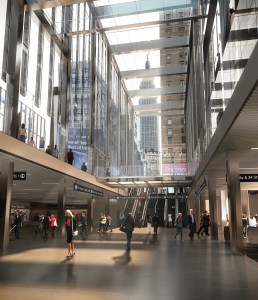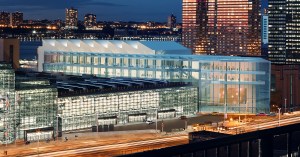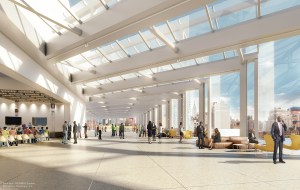Cuomo Commits Big Bucks to Infrastructure Projects, But Who’s Footing the Bill?
By Terence Cullen January 11, 2016 1:31 pm
reprints
In a single week, Gov. Andrew Cuomo might have become one of the most prominent real estate developers in New York City.
Leading up to his State of the State address this week, the second-term Democrat rolled out the plans for billions of dollars in infrastructure projects in Gotham. Those changes included a practically new Pennsylvania Station and an expansion of the Jacob K. Javits Convention Center by more than half. He also pledged to put Wi-Fi throughout New York City’s subway stations and an additional track on the Long Island Railroad to ease commuter congestion. And the announcements come in the wake of other proposals such as a new LaGuardia Airport and a new Tappan Zee Bridge, which are expected to cost $4 billion each, as well as an additional train tunnel under the Hudson River.
While several of these projects are an extension of existing, decade-old plans, some in the real estate industry welcomed the announcements, although there are lingering questions about where the money is coming from. The city’s economy is currently thriving, with private-sector construction popping up in Manhattan, Brooklyn and Queens at full speed as public-sector spending has shown signs of lagging. More people are coming into the city, further straining the already crumbling infrastructure in New York.
“The place is booming,” Richard Anderson, the president of the New York Building Congress, said of the city’s current construction market. “The transportation demands are well documented. The subways are as crowded as ever. The ridership is growing on virtually every line. Traffic congestion, pedestrian congestion: These are the products of a booming private-sector economy.”
On Jan. 5, Mr. Cuomo announced he would push for an additional rail on the LIRR, servicing Nassau and Suffolk counties. Mr. Cuomo made a splash the next day when he presented a $3 billion plan to completely redo and extend Penn Station, renaming it the Empire State Complex. Madison Square Garden will stay where it is, but a theater under the arena is expected to be demolished. Building off of a decade-old project that would have extended train service to the James A. Farley Post Office across the street, the new plan is designed to make the rail hub easier to navigate with more light and a grand entrance on Seventh Avenue.

The overhaul essentially nullifies Related Companies and Vornado Realty Trust’s existing plans to renovate the post office, also known as Moynihan Station (named for Sen. Daniel Patrick Moynihan, who died in 2003, and pushed for the post office’s conversion into a station since the early 1990s). Vornado declined to comment via a spokesman. A Related spokeswoman said in a statement that the developer supported Mr. Cuomo’s announcement and suggested the firm was still interested in the Empire State Complex project.
“We applaud the governor’s focus on the revitalization of Penn Station and Moynihan Station,” she said. “The redevelopment will transform the nation’s busiest train station into a modern commuter hub and a gateway befitting the greatest city in the world. We continue to passionately believe in the project and look forward to reviewing the materials.”
This is just the latest chapter in the battle over Penn Station, which began in the mid-1960s before the original structure at the same site was even demolished.
Under the new Penn Station plan, the potential developer or a consortium will pay for most of the overhaul, which could break ground as soon as this year, in exchange for controlling the retail space at the Midtown rail hub.
“If any city epitomizes the relationship between infrastructure and the built environment, it’s New York City,” Mr. Anderson said regarding Penn Station and the other projects. “For years, we’ve been limping along, holding together the infrastructure with baling wire.”
A few avenues to the west at the Javits Center, Mr. Cuomo declared a major 1.2-million-square-foot expansion to make it a 3.3-million-square-foot complex. That’s highlighted by a new, 60,000-square-foot ballroom, which the governor said would be the largest in the Northeast, and gives the Javits Center 500,000 square feet of contiguous exhibition space.
“We have a series of mass transportation programs, because if this region is going to continue to grow, it’s going to be our mass transportation system that makes it possible,” Mr. Cuomo said at the Javits Center announcement on Jan. 7, a day after the Penn Station announcement. “The answer is not going to be more people getting into more cars and driving into the city. The answer is going to be people getting out of cars and getting into mass transit that is fast, that is comfortable, that is environmentally friendly and coming in to New York.”
The governor’s office touted the Javits Center and its 177 events in 2014 as a major economic generator for New York City and its hospitality industry. The question is, however, how the state, which controls the Javits Center through the Empire State Development Corporation, plans to pay for this and the slew of other public works projects such as the Javits Center, LaGuardia and the Tappan Zee Bridge.

“He’s trying to be Santa Claus,” said Douglas Muzzio, a political science professor at Baruch College. “How he pays for this, I think it’s a lot of wishing and hoping.”
While Penn Station will be mostly funded by whoever wins the redevelopment bid, Mr. Muzzio said there have been past occurrences in which a deal doesn’t work out and the cost falls on the taxpayers.
Mr. Muzzio noted that earlier last week, the governor said he planned to freeze tolls on the Tappan Zee Bridge, which links Rockland and Westchester Counties, through 2020, as well as tolls on the New York State Thruway—keeping a source of revenue where it is. The state would subsidize the bridge and the 570-mile highway with $1 billion over that time, as a new bridge is under construction.
“You might have shovels in the ground,” Mr. Muzzio said. “But you don’t have money in the bank account.”
Mr. Cuomo’s options for funding these projects include selling state bonds, Mr. Muzzio said, as well as using some of the remaining money from the state’s settlement with major banks from the 2008 mortgage meltdown, which was settled in 2014 for $4.5 billion.
When you put all of the projects together, this would likely be one of the biggest public works projects in New York’s history. Mr. Cuomo said several times last week that the proposals were the “most aggressive development program” the state has ever seen. Indeed, it would be on par with Gov. Nelson Rockefeller’s Empire State Plaza, a collection of office buildings housing state departments, in Albany during the 1960s and 1970s, which Mr. Cuomo mentioned in several speeches last week along with the Erie Canal—New York’s first ambitious infrastructure project.
And while most agree the current rollout is a major boon for the city, it comes in the wake of years of private companies doing the lifting. New York City construction spending was estimated to have hit $39 billion in 2015, which was heavily made up of commercial and residential building by the private sector, according to an October 2015 forecast report by the Building Congress. Spending is only expected to go up for the time being and will hit $41 billion this year, followed by $40.8 billion in 2017.

But government spending for things such as roads, mass transportation and related infrastructure was projected to be just $12.6 billion last year, down from $13.4 billion in each 2013 and 2014. If that number turns out to be right, public works spending would be at its lowest since $11.8 billion in 2006. That number is supposed to rise, however, to $14.5 billion this year and to $16.3 billion the year after.
Public-private partnerships, like the scenario for Penn Station in which the developer pays for most of the project, could be a way going forward to fund improvements to mass transit, roads and other infrastructure needs, said Kathryn Wylde, the president and chief executive officer of the pro-business Partnership for New York City. While these have been wildly successful in Europe and Asia, she said, the United States has been slow to adapt.
If the Penn Station project is successful, it could spur further development using the same roadmap, Ms. Wylde said.
“We have a long way to go,” she said. “The point is that the demands on the public capital budget are much greater than they can keep up with. This is really an important first step that the governor is taking, but hopefully it is only the beginning.”



